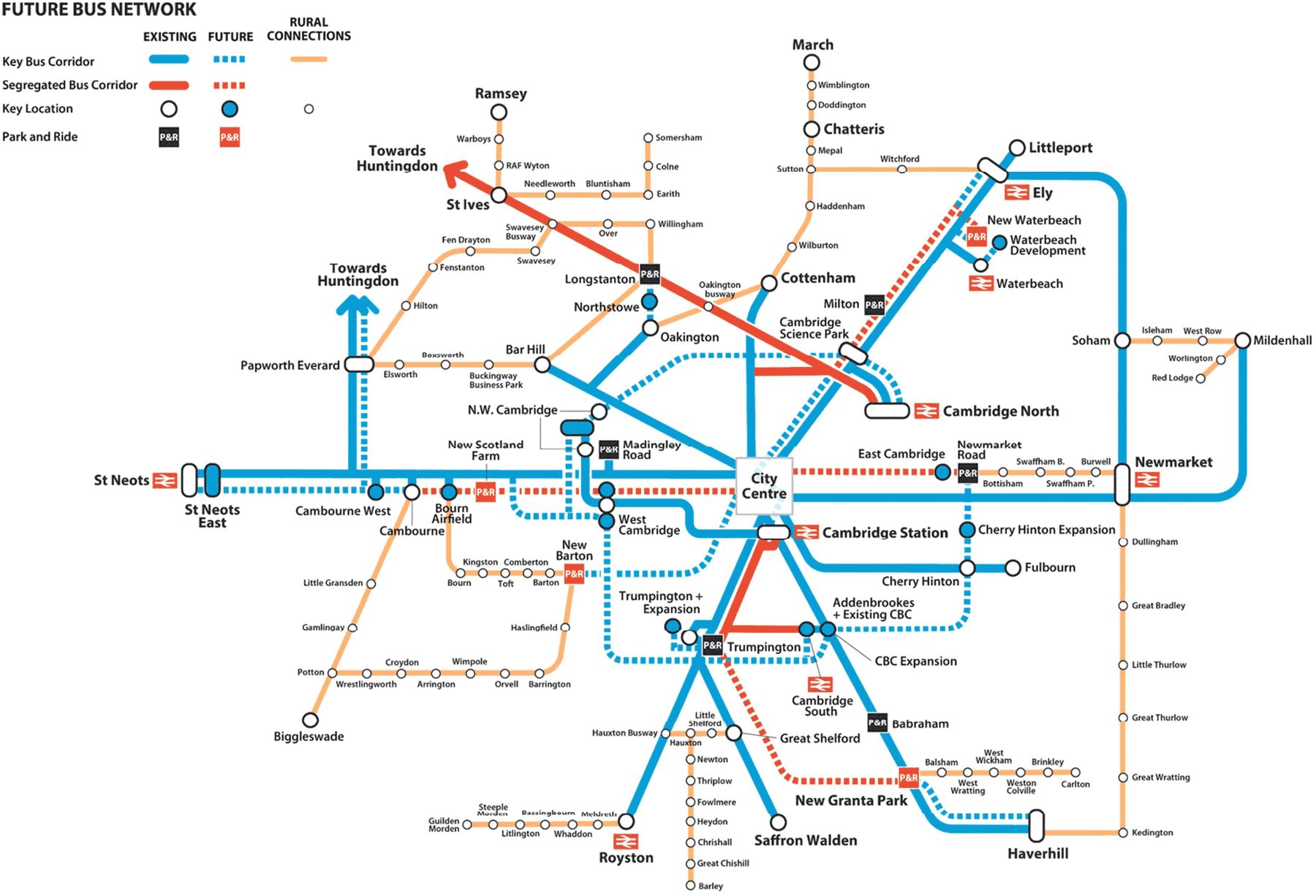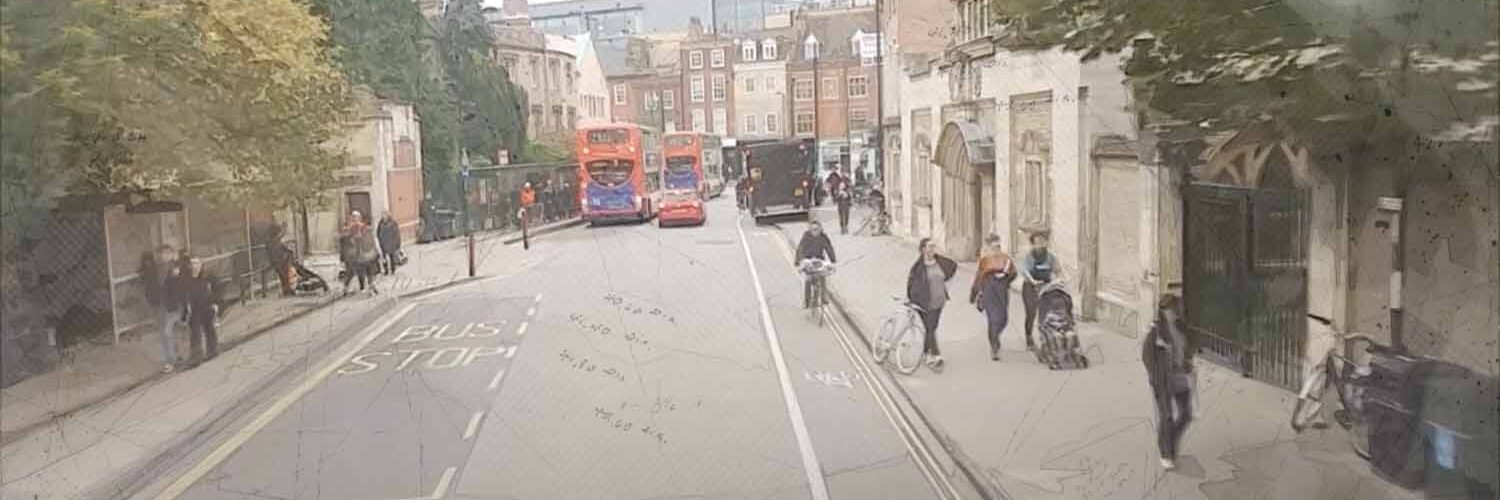The much-anticipated Public Transport Improvements and City Access Strategy report was published on Friday. This workstream is crucial to the success of the entire £750 million Greater Cambridge Partnership (GCP) programme for improving transport in the region.
The report’s introduction covers the changing context, such as the demise of the CAM “metro”, potentially permanent changes to travel patterns due to COVID, and the rapidly evolving government agenda on decarbonising transport, promoting active travel (principally walking and cycling) and improving bus services. The report could have added to that list the reform of rail services, and improving integration of all modes of travel.
The “clear risk of a car-based recovery” from COVID lends a sense of urgency to the recommended actions. However, the report does not acknowledge the urgency created by the climate crisis nor by the deaths and chronic illness that air pollution and collisions involving motor vehicles cause.
Statements of the obvious
The report refers to preceding technical work, which has shown that:
- Any package needs to combine interventions to support the uptake of public transport with one or more measures to discourage car use in order to maximise impact and free up road space;
- The scale of the challenge is such that significant measures are needed to address the issues; and
- The introduction of measures that discourage car use must be timed to ensure people have alternatives in place first.
It doesn’t strike me that one needs to do much, if any, technical work to arrive at these statements of the bleeding obvious. But, let’s treat them as mood music, and move onto the main course. What will these “measures” be? We are told they will comprise a “final package of options” to include:
- Bus network improvements, based on the outlined ‘future bus [network] concept’ including lengthening operating hours, increasing bus frequencies, and reducing fares, and;
- Proposals which prioritise road space for sustainable and active transport, and;
- Measures that provide an ongoing funding source for the enhanced public transport network and more of the cycling-plus network across Greater Cambridge, for example parking or road charge.
I’m not sure (1) is all that futuristic. Point (2) is just a statement of general intent. And (3) is, well, not very informative.
We need to dig deeper.
Future bus network: ambitious but worryingly incomplete
Encouragingly, the ambition is to run buses in Cambridge and from “most market towns” between 5am and midnight at a 10-minute frequency during the day, and 20-minute in the evening.
However, villages not on a “key bus corridor” are likely to have only an hourly service. And the ‘future bus network concept’ is worryingly incomplete. For instance, Sawston, Pampisford, Whittlesford, Duxford, the Imperial War Museum, Hinxton, Ickleton, Great and Little Chesterford and Littlebury are all omitted. A few, like Sawston, presumably lie on the “key bus corridor” from Saffron Walden, but how will the other villages be served? And why are there no services to Whittlesford Parkway railway station?

The kicker is that even these modest plans are estimated to cost £40 million per annum. GCP could fund them “initially” (for how many years isn’t stated), but a new funding stream will be needed to sustain it. The government isn’t offering one, and there is no suggestion it could be raised via Council Tax (it would add over £300 on average to bills in Cambridge and South Cambridgeshire).
So, we have a proposal for a “flexible road charge linked to time of day,” otherwise known as a congestion charge. This “would apply to journeys within a zone covering the city within the bounds of the Park & Rides. Vehicle exemptions would be considered for emergency vehicles and blue badge holders.”
No clear proposal on road charging
How much might this “flexible charge” be? We have to dive into another report to find that out. Atkins did some research last year with the county’s road transport model to test the impact on traffic levels if the charge was £5 or £10 per day, and if it was applied 7am to either 10am or 7pm.
The aim of the exercise was to see which of these scenarios would lead to a 10% reduction in morning peak hour traffic relative to 2015. It is odd to have tested only a 10% reduction when GCP’s actual target is more like a 20% reduction (10–15% on 2011 levels). Anyway, the modelling showed that, in 2031, a £5 all-day charge would reduce morning traffic by more than 10%, even with an exemption for electric and hybrid vehicles. But to reduce the evening peak to the same level would require a £10 all-day charge with no exemption for electric or hybrid vehicles.
Modelling of this sort makes highly debatable assumptions about human behaviour, future costs, and what options people will have available to them. It also only looks at average behaviour; it doesn’t consider the impacts at an individual level.
So what’s the plan?
What new travel options are GCP planning to put in place? We already know about the infamous busways and new car parks and the cycle greenways from South Cambridgeshire villages. Now we have a proposal to greatly increase the frequency and operating hours. The modelling work assumed a doubling of services, from 82 per hour. When I last checked, in 2018, there were 120 bus arrivals in the city centre between 8am and 9am. It is most unlikely that the main bus stops or city centre streets could cope with double that number of bus movements. Even now, buses can be log-jammed on Emmanuel Street.
Walking and cycling through the city centre would be much more intimidating and stressful. So, what’s the plan?
Silence.
The recommendations outlined above are the culmination of six years of research, public engagement and development of ideas. This workstream alone has cost over £9 million. At a day rate of £500, that’s equivalent to over 75 person-years of work, or a team of thirteen qualified, experienced professionals working full-time for six years.
Let that sink in for a moment.
Missing the mark
We are not even at the stage of having definite proposals, just “concepts”. It will require even more consultants’ studies and reports and two more rounds of consultation before we see any changes, possibly starting in 2023. The chance to influence post-COVID travel habits will have long passed.
GCP has already discarded a Workplace Parking Levy, even though it could be a relatively quick way to start raising a revenue to fund more and cheaper bus services, and to incentivise employers to help more of their employees walk, cycle or use public or shared transport to get to work. It would bridge the gap to implementing some form of congestion charge, which will take several years to develop and implement – if it is not overtaken by a government initiative to replace fuel duty with a national road user charge.
GCP’s proposals rely heavily on a few large and expensive Park & Rides. Some of these will be reachable by a “rural connection” bus service. But if you own a car, will you choose to catch a slow, hourly service that winds through several villages to reach a Park & Ride? Patronage of rural services will continue to be low, requiring a high subsidy.
What is needed is a network of rural travel hubs throughout Greater Cambridge, all accessible on foot, cycle or a demand-responsive bus service, and served by express bus services to Cambridge and other major destinations. That’s not in these proposals.
At this crucial juncture on the road to “building back better”, the GCP is demonstrating none of the leadership or imagination needed. Instead, we have continued decision paralysis and a staggering waste of money on half-baked ideas.
This is an extended version of an article published in the Cambridge Independent on 1 September 2021.


